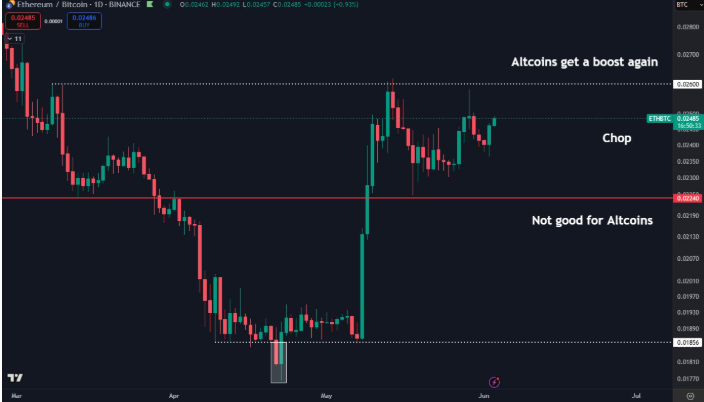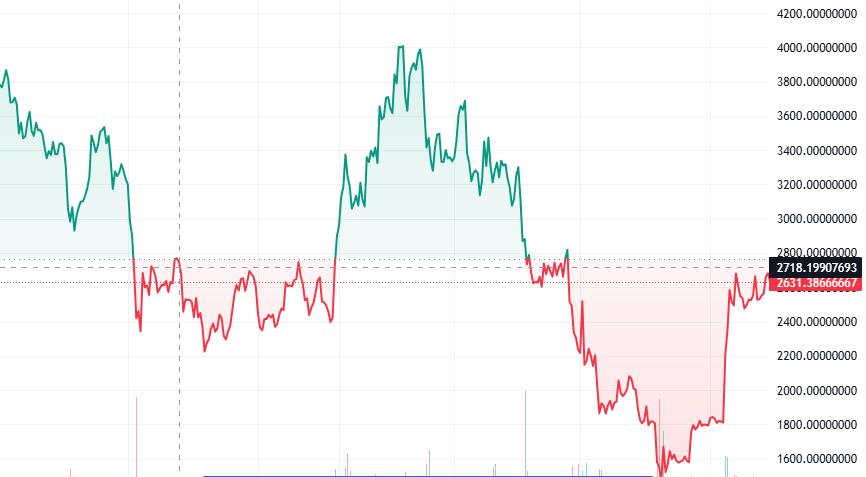The Underestimated "Value Black Hole" is Awakening
In June 2025, the crypto market is experiencing a silent capital migration - Ethereum (ETH) crushes Bitcoin (BTC) with a 30-day surge of 46%, with the ETH/BTC exchange rate breaking through the critical threshold of 0.025, and spot ETF funds net inflow reaching $321 million for 12 consecutive days. Behind these signals is the launch of Ethereum's "Triple Engine": institutional capital suction effect, technological revolution reaching a critical point, and value reassessment under market structural fission. This article will deconstruct this "Ethereum Renaissance Movement" that may overturn the crypto market landscape from the perspectives of underlying data logic, technical structure, and capital game.
Chapter One: Market Anomaly: ETH/BTC Rate Reversal and Capital Migration Tide
1.1 Exchange Rate Revolution: From Marginal Asset to Value Carrier Paradigm Shift

The ETH/BTC exchange rate breaking through the decade-long pressure level of 0.025 marks a fundamental change in the market's valuation logic of Ethereum. The deep driving force behind this breakthrough is:
- Institutional Fund Reallocation: Traditional asset management giants like BlackRock are elevating ETH holdings from "satellite assets" to "core allocation". Data shows that BlackRock's spot ETH ETF holding cost has covered the 3,300-3,500 USD range, while the recent market price is only 2,600 USD, indicating a clear institutional intention to buy the dips.
- ETF Fund Suction Effect: As of June 3rd, Ethereum ETF has net inflows of $321 million for 12 consecutive days, while Bitcoin ETF outflowed $12.3 million in the same period. This "seesaw effect" confirms the capital migration from BTC to ETH.
- Staking Yield Discounted Model: Ethereum's annual staking yield is about 4.5%. According to the DCF model, its long-term valuation floor has moved up to 3,000-3,500 USD, representing over 30% discount from the current price.
1.2 Technical Resonance: Cup and Handle Pattern Overlapping with Macro Cycle

The ETH/USD monthly chart is replicating the 2016-2017 bull market structure:
- Cup and Handle Pattern Breakthrough: After a 3-year cup formation (2021-2024), the current price has broken through the 2,500 USD neckline, with volume compliance reaching 1.3 times of similar historical stages.
- Macro Range Breakthrough: ETH breaks through the lower edge of the 2,500-4,000 USD macro range. If it holds this position, the medium-term target points to 6,000-8,000 USD.
Chapter Two: Triple Engine - Structural Support for ETH Breakthrough
2.1 Engine One: ETF Suction Effect and Institutional Pricing Rights Competition
Ethereum ETF is becoming a "new entry" for traditional capital into the crypto market, with underlying logic far beyond Bitcoin ETF:
- Staking Yield Assetization: BlackRock is lobbying SEC to approve staking ETH ETF. If successful, Ethereum will become the first "interest-generating digital asset", with expected annual yields attracting long-term capital like pension and insurance funds.
- Capital Efficiency Difference: Ethereum ETF management fee rate (0.25%) is significantly lower than Bitcoin ETF (0.5%-1.5%), with low-cost advantages accelerating capital inflow.
- Liquidity Black Hole Effect: ETH spot ETF daily average trading volume has reached 45% of BTC ETF, but market value is only 1/5 of the latter, with significant liquidity premium space.
2.2 Engine Two: Technological Revolution Breaking Through Blockchain Trilemma
Ethereum Pectra upgrade (May 2025) marks the entry of its technical roadmap into the "performance explosion period":
- Transaction Processing Capacity Leap: TPS increased from 30 to 90, gas fees reduced to $0.001 level, first directly competing with high-performance chains like Solana.
- Smart Contract Self-Governance: Through EIP-7002 proposal, staking nodes can programmably trigger withdrawals, providing compliance infrastructure for RWA (real-world asset tokenization).
- Anti-Censorship Capability Upgrade: 51% attack cost under PoS mechanism soars to $3.2 trillion, exceeding global gold reserve market value, becoming an institutional-grade secure asset.
2.3 Engine Three: Market Structure Fission and Altcoin Season Logic Reconstruction
This "altcoin season" differs essentially from 2017/2021:
- Selective Capital Aggregation: Top 10 Layer2 projects occupy 73% of DeFi TVL, AI and DePIN tracks have winner-takes-all, with worthless tokens being eliminated.
- Volatility Arbitrage Opportunities: ETH's historical volatility (90 days) reaches 85%, nearly double BTC's (45%), with derivatives market uncleared contracts surging 120%.
- Regulatory Arbitrage Window: SEC's attitude towards staking ETF turns to "limited opening", providing compliant entry channels for institutional capital.
Chapter Three: Risk Variables - Undercurrents and Regulatory Game Behind the Carnival
3.1 Regulatory Black Swan: Legality Game of Staking ETF
SEC's review of Grayscale Ethereum ETF (deadline June 3rd) may trigger short-term volatility:
- Staking Yield Attribute Controversy: SEC may define staking yield as "securities interest". If the application is rejected, short-term price might retrace to $2,300.
- Institutional Lobbying Power: BlackRock has assembled a lobbying team of over 50 people, pushing SEC to pass ETH staking ETF by 2025Q3.
3.2 Technical Pullback Pressure: Overbought Signals and Liquidity Trap
ETH's RSI (daily) has touched 75 overbought zone, with derivatives funding rate rising to 0.03%
- Beware of the following risks: Leveraged Liquidation Chain Reaction: 12 billion long leverages concentrated in 2,500-2,600 USD range, with 5.32 billion forced liquidation.
- Whale Selling Pressure: Top 10 addresses have accumulated 1.2 million ETH in the past two weeks, with cost around $2,400, presenting motivation for profit-taking.
Chapter Four: Historical Mapping and Valuation Reconstruction - Can Trillion-Dollar Narrative Be Fulfilled?
4.1 Cycle Comparison: Three Major Differences in This Bull Market
- Institutional-Led Pricing: ETH ETF management scale has reached 3 times BTC ETF at the same period, with traditional capital's discourse power enhanced.
- Technological Generation Difference: PoS+sharding technology makes Ethereum the first public chain capable of carrying trillion-dollar RWA.
- Regulatory Compliance: US and EU crypto laws clearly define ETH as "commodity", eliminating policy uncertainty.
4.2 Valuation Model: Target Range from Multi-Dimensional Perspectives
- Staking Yield Discounted Model: With 4.5% annual yield + 20x PE, valuation center at $3,500.
- Ecosystem Value Capture Model: DeFi TVL (8.5 billion) occupies ETH market value ratio reaching 323,400 billion (ETH $8,500).
- Institutional Target Divergence: Standard Chartered Bank bullish to $14,000, ARK Invest conservatively predicts $5,000.
Chapter Five: Investor Survival Guide - Finding Real Value in Narrative Bubble
5.1 Position Management: Three Rules to Counter Extreme Volatility
- "Zero-loss Tolerance" Principle: Altcoin position ≤10%, ETH main position stop loss set at $2,300 (-12%).
- Hedging Strategy: Buy ETH put options (strike price $2,400) + long BTC volatility.
- Liquidity Reserve: Retain 30% cash to address potential SEC black swan event.
5.2 Track Selection: Survival Logic in the Winner-Takes-All Era
- Layer2 Infrastructure: Top three L2 (Arbitrum, Optimism, StarkNet) occupy 80% market share.
- RWA Protocols: BlackRock BUIDL fund 95% asset tokenization on Ethereum, annual yield 6.5%.
- Decentralized Computing Power: Akash, Render and other DePIN projects TVL monthly increase 120%.
Conclusion: "Paradigm Revolution" and Value Reassessment in the Crypto World
Ethereum's breakthrough is far more than mere price fluctuation, but a "paradigm revolution" driven by technological revolution, capital migration, and regulatory evolution. When $2,500 transforms from resistance to support, when staking ETF opens up a trillion-dollar RWA market, when ETH/BTC exchange rate breaks through decade-long constraints, we are witnessing the prelude to a new era - there is no "eternal altcoin season", only the victory of long-termism based on real value capture.







